Learning to Improve: How America’s Schools Can Get Better at Getting Better
Anthony S. Bryk, Louis M. Gomez, Alicia Grunow, and Paul G. LeMahieu. Harvard Education Press, 2015, 256 pp. Principal, March/April 2016
 Anthony S. Bryk, Louis M. Gomez, Alicia Grunow, and Paul G. LeMahieu.
Anthony S. Bryk, Louis M. Gomez, Alicia Grunow, and Paul G. LeMahieu.
Harvard Education Press, 2015, 256 pp.
Principal, March/April 2016
The authors of Learning to Improve were tired of witnessing educational reforms implemented haphazardly as a result of countless new ideas. All too often, the reforms were not given time to work or were not data- or research-driven. Bryk and his colleagues decided to delve into some of the most trusted tenets of improvement science, found across a variety of professional fields, and break them down into how they can greatly impact the educational process— either with an individual student, or within a school.
Learning to Improve is based on six improvement principles for establishing better educational practices. Each chapter gives the history behind the strategy, provides detailed research to support the practice, and also includes real-world examples of the strategy in action. These practices range from the narrow view of focusing on a specific problem and being user-centered, to spiraling outward and using effective networking techniques.
One section that hit particularly home for me was a chart detailing all the responsibilities and relationships new teachers must contend within their first year. The chart reminded me of one of those styrofoam solar system models, with the poor teacher playing the part of the sun with numerous toothpicks sticking out, leading to other demands on his or her time. The chapter then points out that research shows that new teachers are either given feedback from too many unreliable sources, or given no feedback at all. The authors plead for new teachers to receive consistent feedback from a limited number of reliable sources.
Learning to Improve is not an easy read or a quick-fix book. The ideas are explained in true depth and the research vernacular gets a bit heavy at times. The book, however, boasts authors who are at the very top of their fields and who bring the principles back to the practical realm. I often found myself stopping to ponder a key point and then making notes about how it could relate to my school and my students. If you commit the same time and patience to Learning to Improve, you’ll find yourself doing the same.
Reviewed by Brian Bond, principal of Hunter Hills Elementary School in Corbin, Kentucky.
Copyright © National Association of Elementary School Principals. No part of the articles in NAESP magazines, newsletters, or website may be reproduced in any medium without the permission of the National Association of Elementary School Principals. For more information, view NAESP’s reprint policy.

